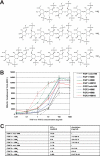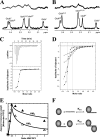Influence of heparin mimetics on assembly of the FGF.FGFR4 signaling complex
- PMID: 20547770
- PMCID: PMC2924102
- DOI: 10.1074/jbc.M109.095109
Influence of heparin mimetics on assembly of the FGF.FGFR4 signaling complex
Abstract
Fibroblast growth factor (FGF) signaling regulates mammalian development and metabolism, and its dysregulation is implicated in many inherited and acquired diseases, including cancer. Heparan sulfate glycosaminoglycans (HSGAGs) are essential for FGF signaling as they promote FGF.FGF receptor (FGFR) binding and dimerization. Using novel organic synthesis protocols to prepare homogeneously sulfated heparin mimetics (HM), including hexasaccharide (HM(6)), octasaccharide (HM(8)), and decasaccharide (HM(10)), we tested the ability of these HM to support FGF1 and FGF2 signaling through FGFR4. Biological assays show that both HM(8) and HM(10) are significantly more potent than HM(6) in promoting FGF2-mediated FGFR4 signaling. In contrast, all three HM have comparable activity in promoting FGF1.FGFR4 signaling. To understand the molecular basis for these differential activities in FGF1/2.FGFR4 signaling, we used NMR spectroscopy, isothermal titration calorimetry, and size-exclusion chromatography to characterize binding interactions of FGF1/2 with the isolated Ig-domain 2 (D2) of FGFR4 in the presence of HM, and binary interactions of FGFs and D2 with HM. Our data confirm the existence of both a secondary FGF1.FGFR4 interaction site and a direct FGFR4.FGFR4 interaction site thus supporting the formation of the symmetric mode of FGF.FGFR dimerization in solution. Moreover, our results show that the observed higher activity of HM(8) relative to HM(6) in stimulating FGF2.FGFR4 signaling correlates with the higher affinity of HM(8) to bind and dimerize FGF2. Notably FGF2.HM(8) exhibits pronounced positive binding cooperativity. Based on our findings we propose a refined symmetric FGF.FGFR dimerization model, which incorporates the differential ability of HM to dimerize FGFs.
Figures






Similar articles
-
Differential effects of heparin saccharides on the formation of specific fibroblast growth factor (FGF) and FGF receptor complexes.J Biol Chem. 2002 Jan 25;277(4):2444-53. doi: 10.1074/jbc.M108540200. Epub 2001 Nov 19. J Biol Chem. 2002. PMID: 11714710
-
Cooperative heparin-mediated oligomerization of fibroblast growth factor-1 (FGF1) precedes recruitment of FGFR2 to ternary complexes.Biophys J. 2013 Apr 16;104(8):1720-30. doi: 10.1016/j.bpj.2013.02.051. Biophys J. 2013. PMID: 23601319 Free PMC article.
-
Heparin-dependent fibroblast growth factor activities: effects of defined heparin oligosaccharides.Eur J Cell Biol. 1997 May;73(1):71-80. Eur J Cell Biol. 1997. PMID: 9174673
-
A protein canyon in the FGF-FGF receptor dimer selects from an à la carte menu of heparan sulfate motifs.Curr Opin Struct Biol. 2005 Oct;15(5):506-16. doi: 10.1016/j.sbi.2005.09.002. Curr Opin Struct Biol. 2005. PMID: 16154740 Review.
-
Interaction of heparins with fibroblast growth factors: conformational aspects.Curr Pharm Des. 2007;13(20):2045-56. doi: 10.2174/138161207781039733. Curr Pharm Des. 2007. PMID: 17627538 Review.
Cited by
-
NMR resonance assignment of a fibroblast growth factor 8 splicing isoform b.Biomol NMR Assign. 2023 Jun;17(1):135-142. doi: 10.1007/s12104-023-10132-8. Epub 2023 Apr 29. Biomol NMR Assign. 2023. PMID: 37118562 Free PMC article.
-
Computational drill down on FGF1-heparin interactions through methodological evaluation.Glycoconj J. 2017 Jun;34(3):427-440. doi: 10.1007/s10719-016-9745-4. Epub 2016 Nov 17. Glycoconj J. 2017. PMID: 27858202 Free PMC article.
-
Interactions between a Heparin Trisaccharide Library and FGF-1 Analyzed by NMR Methods.Int J Mol Sci. 2017 Jun 17;18(6):1293. doi: 10.3390/ijms18061293. Int J Mol Sci. 2017. PMID: 28629128 Free PMC article.
-
Novel regulation of fibroblast growth factor 2 (FGF2)-mediated cell growth by polysialic acid.J Biol Chem. 2012 Feb 3;287(6):3710-22. doi: 10.1074/jbc.M111.276618. Epub 2011 Dec 12. J Biol Chem. 2012. PMID: 22158871 Free PMC article.
-
Achieving high signal-to-noise in cell regulatory systems: Spatial organization of multiprotein transmembrane assemblies of FGFR and MET receptors.Prog Biophys Mol Biol. 2015 Sep;118(3):103-11. doi: 10.1016/j.pbiomolbio.2015.04.007. Epub 2015 May 5. Prog Biophys Mol Biol. 2015. PMID: 25957048 Free PMC article. Review.
References
MeSH terms
Substances
Grants and funding
LinkOut - more resources
Full Text Sources
Other Literature Sources
Medical
Miscellaneous

